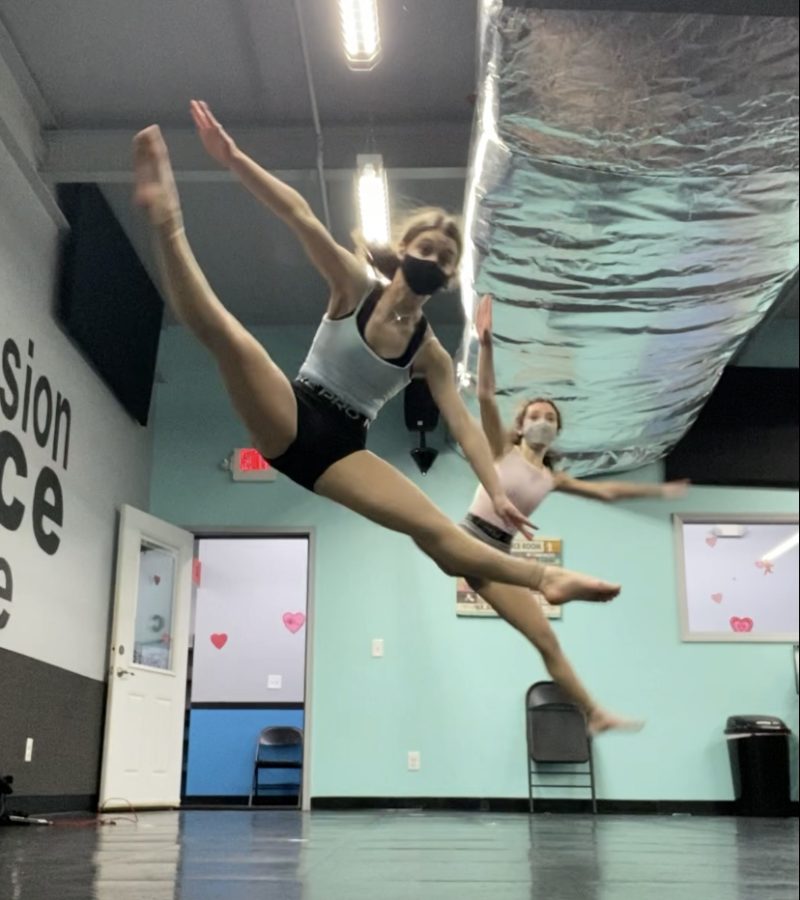Leaping into new respect: Why dance should be considered a sport
Photo courtesy of Sophie Latessa
Sophie Latessa “leaping into respect.”
At every family gathering, a distant relative will ask me “So, what’s your sport?” “I’m a competitive dancer,” I answer. They proceed to give me a look which indicates they don’t think that counts as a sport at all. “How nice,” they’ll say.
Dance has long been thought of as an art and not a sport, however it is in fact a sport and people continue to overlook how challenging it is. According to dictionary.com, the definition of a sport is “an activity involving physical exertion and skill in which an individual or team competes against another or others for entertainment.” Dance meets all of this criteria. Dancers are often disregarded as athletes even though their craft is arguably harder to develop and more physically demanding than other sports.
While dance obviously doesn’t entail frequent games as many other sports do, dancers compete at competitions against other individuals or studios, similar to gymnastics competitions. Dance also doesn’t have a specific season; dancers are year-round athletes and professional dancers go to competitions on a regular basis.
Dancers work extremely long hours to perfect their skills. Personally, I dance about 15 hours in an average week, and professional dancers spend up to six full days a week training. In most professional ballet companies, rehearsal could start at 10 a.m. and go until 6 p.m., with breaks, according to channel4.com.
And although it is a dancer’s job to make everything look effortless, dance is physically grueling. Because of the high stress dancers put on their bodies, most professional dancers retire around their mid-30s, according to dancefacts.net.
Dancers also struggle with many injuries. In a survey about injuries in modern/contemporary dance, it was found that 82 percent of dancers who completed the questionnaire had between one and seven injuries in their career, according to the National Library of Medicine.
Dance is clearly challenging and requires an equal if not greater amount of athleticism to other sports, however it is often not considered a sport because it is not included in the NCAA and rarely included in high school sports.
Part of this is an issue with female representation in sports, as 67.1 percent of dancers are women, according to zippia.com. Although many women compete in high school and college level sports, dance is female-dominated and would introduce a whole new group of female athletes to these higher levels of competition.
The history of the sport has long been overlooked. Skilled high school and college dancers deserve the chance to be recognized as what they are, athletes, in the NCAA and on the high school sports level.
People debate whether dance is a sport or an art, but why can’t it be both?


ur mom • Nov 19, 2024 at 9:34 am
totally agree!!!!!!!!!
ur mom • Nov 19, 2024 at 9:28 am
I totally agree!!!!
Scarlett • Apr 24, 2024 at 10:25 am
Dance is most definitely a sport.
ur mom • Feb 6, 2024 at 10:48 am
Yes! I have been dancing since for 10 years. Since I was two. It is a lot of hard work and should definitely be considered as a sport.
fdc • Oct 1, 2023 at 6:00 pm
fr i say the same thing. ipl.org states that “it is a performance, instead of a game, that is scored, it is not always competitive, and it mostly involves emotion, passion, and artistry”
like they don’t even realize that we are being scored when we are judged in competitions. IT IS COMPETITIVE.
also why are figure skating and gymnastics sports? they have plenty of art in them. you use emotion and passion in them too. JUST LIKE DANCE.
thx 4 making this sophie ♡ we miss u at dance. hope ur liking college
Ally • Apr 3, 2023 at 2:37 pm
yes!
Someone • Feb 17, 2023 at 12:30 pm
I agree
Paula Latessa • Feb 8, 2022 at 8:51 am
I agree, my granddaughter has been in a dance troop since 3 and I to believe it is a sport.Sophie is definitely right.